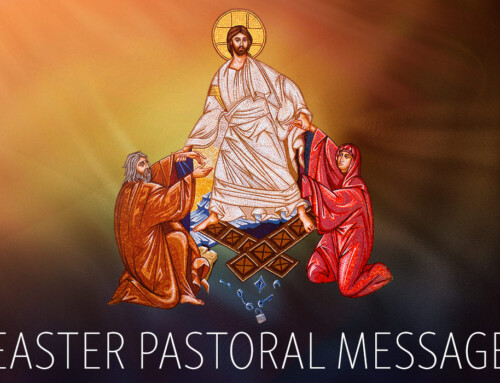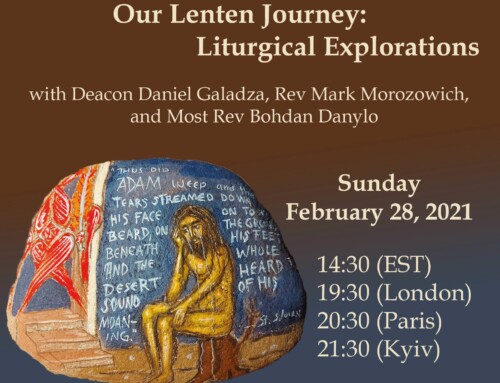Catechetical Sermon on the Divine Liturgy
# 6 . The Homily: “the president of the assembly speaks to us.”
The Greek word used by the Jews to indicate their place of worship away from the Jerusalem Temple is synagogue, meaning “to bring together,” to gather. And it was customary, even at the time of Jesus, for people to address that gathering. Matthew (4:23) reports that Jesus “went around the whole of Galilee teaching in their synagogues, proclaiming the Good News of the kingdom and curing all kinds of diseases and sickness among the people.” Luke (4:16) tells the story of Jesus reading the lesson from the Prophet Isaiah in the synagogue at Nazareth and preaching afterwards. Justin Martyr says the readings and homilies in the Christian assembly in second century Rome went on “for as long as there was time.” We should remember that, in the Rome of Justin’s time, Sunday was just another day of the week. The “weekend” had not yet been invented, and so the Christians were going to church before they went out to their work that day.
Justin says the “president of the assembly” speaks after the reader has finished. This tells us that in the middle of the second Christian century we already see what we would call today “pastors” and “lectors.” A pastor may have assistant priests working with him, and so they may take turns with fulfilling their duties toward the congregation. In every case today the local pastor receives his authority to preach from the bishop showing that—in essence—the bishop is the archpastor serving every congregation in his diocese. Besides the bishop and presbyters,
deacons may also preach. One sees this in the Acts of the Apostles (6: & ff.) where St. Stephen preached in the streets and it eventually cost him his life. Many people think of a “homily” as simply another word for sermon, but that is not the case. The Greek term homily means “to have communion or hold verbal interaction with a person,” and in this case, with God in Christ and through the Holy Spirit.
The Church Father Origen distinguished between sermon (λόγος-which depends on reason and logical arguments to make its case) and homily (ὁμιλία-which may use an appeal to authority or even an appeal to the heart). If the reading of the Scriptures is the repetition of the word in a stable and concrete form, the homily is a fluid opportunity for the Holy Spirit to move the preacher to provide to the people several possibilities that the printed word might not have: to explain something not clear in the text, to apply the text to a concrete situation in the present, to move the listener to the spiritual implications of the text and—just as attending a play might be more engaging and interesting than reading a copy of the script—an opportunity to provide a measure of emotional tone to the text to elicit consolation, delight and inspiration from the Scripture through the Spirit.
Катехетична Проповідь про Божественну Літургію
# 6. Проповідь: «Голова зібрання промовляє до нас»
Грецьке слово, яке використовують євреї, щоб вказати на місце, де проводилися богослуження, крім Єрусалимського Храму, є синагога, що означає «зібратися разом». Навіть, за часів Ісуса існував звичай збиратися людям на такі зібрання. В Євангелії (Мт. 4:23) читаємо про те, що Ісус «ходив по всій Галілеї навчаючи в їхніх синагогах, проповідуючи Добру Новину про Царство і лікував недугу і всяку неміч серед людей.” У Євангелії (Лука 4:16) розповідається історія про Ісуса, який читає уривок з пророка Ісаї в синагозі в Назареті і згодом проповідує. Юстин Мученик каже, що читання і проповіді на християнському зібранні в другому столітті у Римі тривали так довго, «поки був час. » Ми повинні пам’ятати, що в Римі в часи Юстина, неділя була просто ще одним днем тижня. «Вікенд» ще не було винайдено, тому християни ходили до церкви перед початком праці у той самий день.
Юстин каже, що «голова зібрання» промовляв після того, як читач закінчив читати. Це говорить нам про те, що в середині другого християнського століття ми вже бачимо тих, кого ми називаємо сьогодні «парохів» і «читців». Парох може мати також священика, який допомагає йому та працює з ним, і тому вони можуть почергово виконувати свої обов’язки на зібранні. У будь-якому випадку сьогодні місцевий парох отримує від єпископа право проповідувати, підкреслюючи тим самим, що єпископ є архипастирем, який служить кожній спільноті в своїй єпархії. Крім того, єпископ, пресвітери, диякони можуть проповідувати. Це бачимо у Діяннях Апостолів (6 : & ff), де Святий Стефан проповідував на вулицях і в результаті це коштувало йому життя. Багато людей думають про «проповідь», як лише про звичайну промову, але це не так. Грецький термін «Проповідь» означає «спілкуватися або розмовляти з людиною», і в цьому випадку, з Богом у Христі через Святого Духа.
Отець Церкви Оріген розрізняв проповіді (λόγος, яка побудована на раціональних та логічних аргументах) та іншу проповідь (ὁμιλία, яку застосовували у зверненні до влади або, навіть, у зверненні до серця). Якщо читання Св. Письма є повторенням слова в стабільній і конкретній формі, то Проповідь є нагодою для Святого Духа діяти через проповідника, який може пояснити незрозумілі тексти, звернути увагу слухача на духовні аспекти тексту, надати людям те, що друковане слово може не мати, подібно як дивитися п’єсу є цікавіше, ніж читати копію її сценарію, а також застосовувати текст до конкретної ситуації, передаючи розраду, радість і натхнення, які випливають із Св. Письма через Святого Духа.





